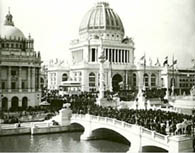In
this essay, we look at another method of doing cultural anthropology.
Ethnography
is not the only way that anthropologists learn about
another culture. They can also select a specific cultural event
and deconstruct it to discover the kinds of discourses—the
representations that shape the way a particular topic is conceived
and experienced.
In this case, we will consider the ways in which Indian images
are marketed to the American public. In the process, we will
also see
how cultural anthropologists use the past to understand the present.
The
event we will focus upon is the Columbian Exposition of
1893, a World’s Fair that was held on the shores
of Lake Michigan in Chicago from May to October of 1893.
The Chicago
World’s Fair was an incredibly popular and immensely
influential social and cultural event. Though it existed
for only six months, it drew over 27 million visitors from
every state in the United States and a fair percentage
of foreign countries as well—this is especially dramatic
considering the difficulties of travel during this period. |
 |
Continue to Page 2
|

